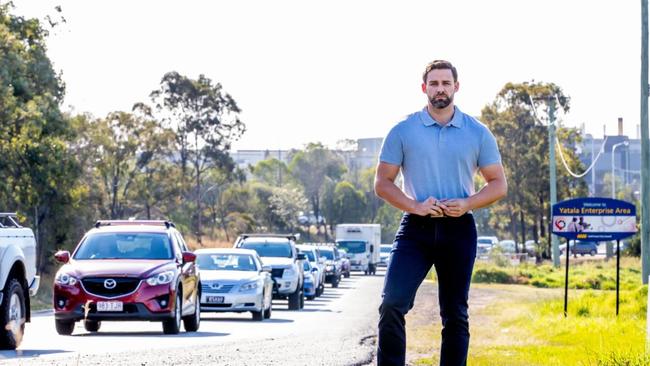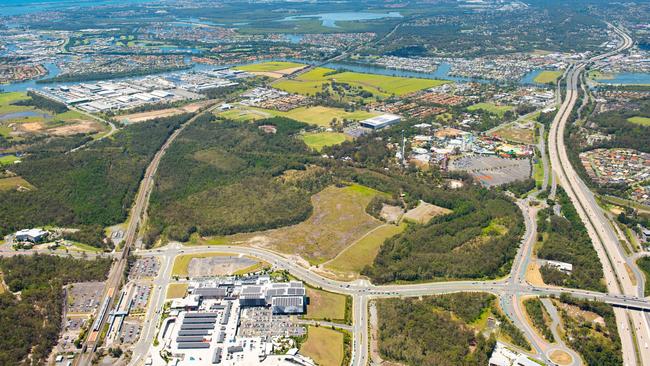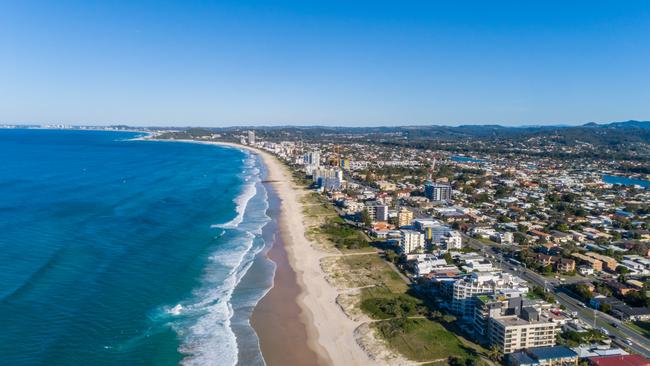Shock admission: Authorities ’caught out’ by Gold Coast’s rapid growth
Authorities have been “caught out” by the Gold Coast’s fast growth and are “too far behind” to catch up with infrastructure like roads and schools, warns a newly-elected city councillor. IS HE RIGHT? VOTE IN OUR POLL
Gold Coast
Don't miss out on the headlines from Gold Coast. Followed categories will be added to My News.
ALL levels of government have been “caught out” by the Gold Coast’s fast growth and are “too far behind” to catch-up with infrastructure like roads and schools, a city councillor warns.
Division One councillor Mark Hammel, who was elected in March last year and represents the Coast’s north, in a stunning admission says both state and federal governments and the council must change their model of delivering infrastructure.

A Bulletin report has revealed Coast suburbs are recording the biggest population jumps in the statewide, and the pressure is creating ugly developments with some more than 500 per cent above the allowable density.
Pimpama had the largest jump of any suburb in the State, up 2666 between 2019 and 2020, followed by Coomera, Surfers Paradise, Upper Coomera and Ormeau.
“In my opinion, we’ve been caught out and are too far behind. We need to change the model and get more infrastructure delivered before the population is there, instead of the current model that allows 20,000 people to move into a new suburb and retrofit the infrastructure afterwards,” Cr Hammel said.
“We need to be bold and instead of a rate base being there first, the city needs to build infrastructure beforehand and provide a better lifestyle and liveability to residents.”
Cr Hammel said there was “still room for a small amount of additional housing” but the vast majority would need to be in infill areas.
This means council must focus on approving higher density and taller tower developments along the coastal strip near light rail and approving medium high rise in some nearby suburbs.
“We have seen 25 years of sustained huge growth in greenfield areas, which needed to happen in a relatively young city, but will have an ongoing cost to the city’s budget for decades to come for investing in that infrastructure,” Cr Hammel said.
“That rate of greenfield development is not sustainable. It is time now to develop small pockets of greenfield locations and revert to a majority of growth in the right infill areas, and to deliver improvements in local infrastructure and connectivity before we allow major infill development to occur.”

FULL DIGITAL ACCESS: JUST $1 A WEEK FOR FIRST 12 WEEKS
Cr Hammel said the city’s north had reached the edge of its current urban footprint.
Population growth would continue at the same rate for the next five years before slowing as the amount of land was exhausted, he added.
“The peak of the population boom is starting to slow on the far northern Gold Coast, but it is not going to stop any time soon, which is why we need to get the balance right in terms of future population growth and infrastructure,” he said.
“If the infrastructure was in place for the current population, I would support more development in this area occurring. But it is unacceptable to have residents who are both old and new to the area sitting in traffic for 40 minutes just to get onto a highway interchange because the State Government is so far behind with their road network.”
Last week, the Bulletin revealed Gold Coast suburbs were recording the state’s biggest population jumps with fears that pressure was leading to crammed developments more than 500 per cent above the allowable density.
The city population soared by 15,000 in 2019-20, only second in numbers for Queensland behind Brisbane.
But the Coast has the fastest rate of growth. Pimpama had the largest jump of any suburb in the state, from 19,427 to 22,093, up 2666, between 2019 and 2020.
Other top growth suburbs were Coomera which went from 18,040 to 19,724, Surfers from 27,022 to 28,160 and Upper Coomera from 36,121 to 37,148.
A town planner advising concerned residents said Main Beach, Palm Beach and Kirra approvals were two to three times those planned for.
“One development recently approved in Kirra is 500 per cent the allowable density and a very poor design,” he said.
NORTHERN GOLD COAST SUBURBS’ STARTLING LANDSCAPE CHANGE
GOLD Coast suburbs are recording the state’s biggest population jumps - but the pressure is creating crammed developments with some 500 per cent above allowable density.
The Coast is growing the most of any city in Queensland behind Brisbane with a jump of almost 15,000 in 2019-20, Queensland Treasury data reveals in terms of population numbers.
In terms of population growth recorded between 2019 and 2020, Pimpama had the largest jump of any suburb in the State, from 19,427 to 22,093. That’s up 2666.
Other top growth suburbs included Coomera (18,040 to 19,724), Surfers Paradise (27,022 to 28,160), Upper Coomera (36,121 to 37,148) and Ormeau (23,023 to 23,677), in data crunched by the Bulletin.
The Coast - in terms of percentage increase - is the third fastest growing city with an annual population surge of 2.4 per cent, behind Ipswich and Sunshine Coast.
Some councillors, community groups and town planners predict without proper policing in planning “we are left with a legacy of pretty awful development”.
Community groups say families are being squeezed into homes on 400 sqm blocks in the city’s north with few parks and community facilities. Older homes in the south sit in the shadow of new apartment towers.
BACKLASH OVER TOWER PLAN FOR COAST SUBURB

Gold Coast property: House values have biggest jump in 15 years as property and development booms
A town planner advising concerned residents said approvals in Main Beach, Palm Beach and Kirra was two to three times what was planned for because developers wanted to exceed targets.
“One development recently approved in Kirra is 500 per cent the allowable density and a very poor design,” the town planner said.
“Others are quickly following. It’s logical to assume that if all land was developed this way then the population targets would be not only met but significantly exceeded without corresponding infrastructure planning.”
Community Alliance president John Hicks was aware of “the 500 per cent Kirra development” and several examples of buildings more than 300 per cent above the density guidelines in Palm Beach. The densities were expected to be reached in another two decades.
“It’s loading up the infrastructure and roads. It’s the irresponsible granting of permission. It’s totally wrong,” Mr Hicks said.

The Community Alliance has written to the Government complaining about excessive development relaxations which had led to bulky buildings leaving “side streets full of parked cars, hot treeless landscapes and a canyon effect along the Gold Coast Highway”.
Government bureaucrats have responded by saying further changes were not needed to the Planning Act.
The Under Treasurer in a reply said councils were responsible for “ensuring planning schemes were efficient, effective, transparent, integrated and co-ordinated, accountable, outcome focused and positive”.

“The Queensland Government would prefer to see councils drafting their own planning schemes in a way that ensure the above principles are achieved before considering amendments to the Planning Act to introduce new assessment pathways,” the Under Treasurer wrote.


